SaaS as a Special Type of the Web App: Characteristics, Specifics, and Comparative Analysis

Key takeaways
- Get a detailed explanation of software as a service (SaaS) and its key characteristics.
- Learn about the benefits of SaaS, such as SaaS web application development scalability, stable revenue flow, and the ability to reach a wide audience.
- Consider the key characteristics of web-based applications, such as flexibility, customization options, data control, and security.
- Let’s explore the main features and characteristics of stand-alone applications and the SaaS model.
- Discover the important factors before choosing a development model for your project.
- Get development inspiration: we have given examples of potential use cases for SaaS and web applications.
When it comes to the comparison of SaaS-based and conventional web applications, the topic is almost always followed by ambiguity. For businesses that plan to enter the market with web-based software, it’s of paramount importance to know the specifics of each solution. It is important to note that although SaaS is a popular model for delivering web applications, not all web applications run on the SaaS model.
The purpose of this article is to point out the main features of each type of app and highlight their distinguishing characteristics, deployment models, and respective business models. By the end of this article, you will have all the information you need to choose the most appropriate option for your business confidently.
What is SaaS? Exploring cloud-based software and its key characteristics
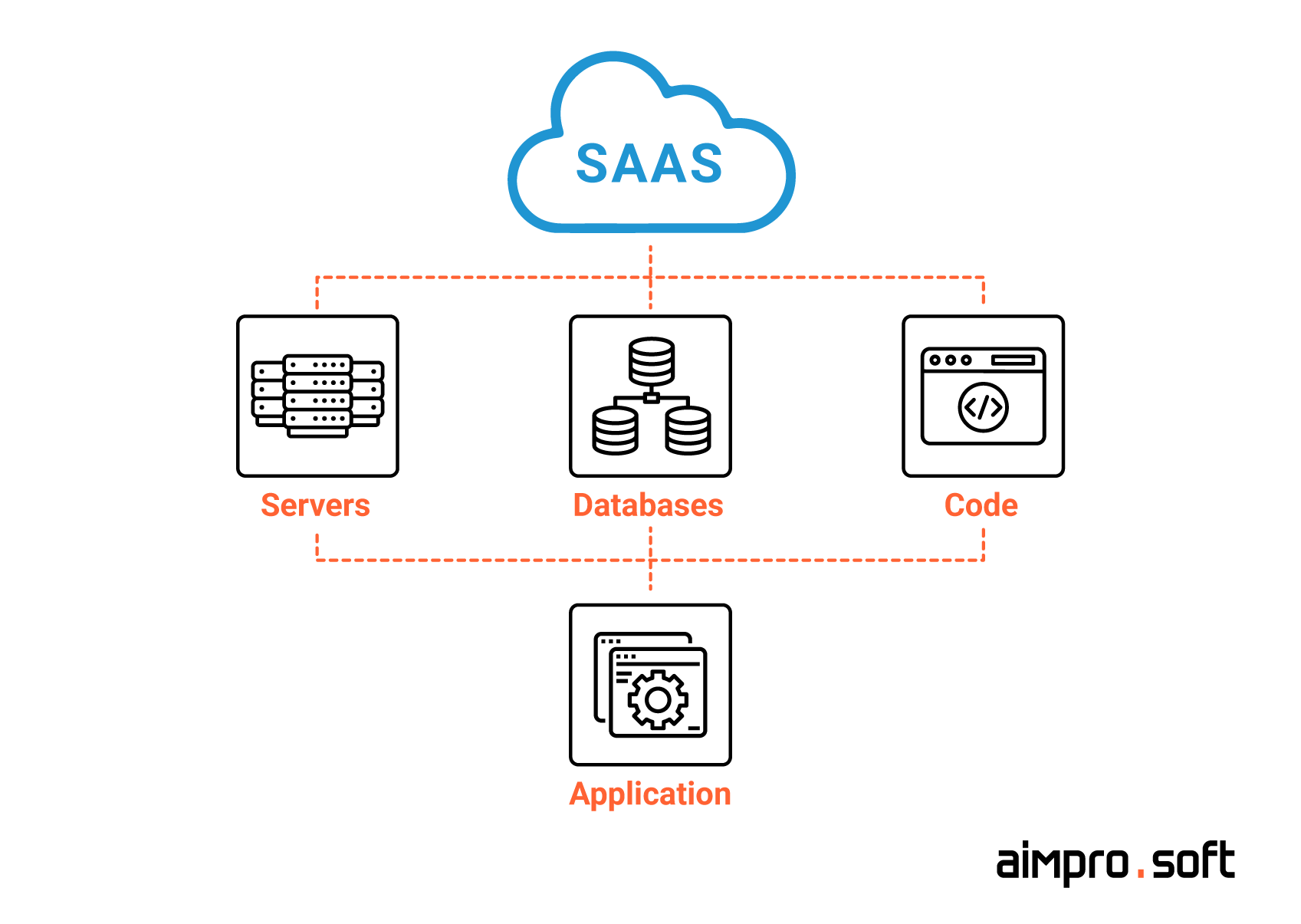
How do SaaS applications work?
SaaS (Software as a Service) is a software delivery model according to which applications are hosted by a service provider and are available to users over the Internet. Instead of buying and installing software on individual devices, users can access and use it through a subscription-based model via a browser. SaaS web applications eliminate the need for upfront investment in infrastructure and provide users with flexibility, scalability, and automatic updates.
SaaS operates on a client-server architecture, where users access the application through web browsers or dedicated client software. The application is hosted on servers in the cloud, allowing for scalability. Data is stored securely, and multi-tenancy enables multiple customers to share the same instance while maintaining data isolation. SaaS platforms often provide APIs for integration with other systems, and updates are deployed automatically to ensure users have the latest features and fixes.
In recent years, we have seen impressive growth of SaaS in popularity; for example, the SaaS market was estimated at $197 billion in 2023 and is expected to reach $232 billion by 2024.
Key features and characteristics
Let’s explore the core features that define the SaaS approach and contribute to its widespread adoption. By delving into these characteristics, we can uncover the fundamental aspects that set SaaS apart from traditional web apps.
Centralized hosting
The software application is hosted on servers managed by the SaaS provider. These servers process and store data, allowing users to access the application from anywhere with an Internet connection.
Multi-tenancy
SaaS based applications are designed to serve multiple customers simultaneously using a multi-tenant architecture. Both the software program and the database are shared by every customer. Data for each renter is separated and inaccessible to other users.
Subscription model
SaaS operates on a subscription-based pricing model. Users pay a recurring fee to access and use the software, often monthly or annually. This subscription fee usually covers software updates, maintenance, and support services. For example, the SaaS platform Dropbox is quite popular, which is not surprising because the platform offers cloud storage, tools for collaboration, security, and a subscription-based pricing model. Such a payment system allows customers to access the service for a monthly or annual fee.
Customization and configuration
SaaS platforms often offer customization options that allow users to adapt the software to their specific needs. This can include customizing settings, configuring workflows, and adjusting the user interface to the organization’s requirements. Among the popular custom SaaS platforms, we can highlight Editor X. With this platform, users can develop complex websites with cutting-edge design, using various layout capabilities as well as website builders where users do not need to have technical knowledge to create a web page for their needs.
Integration capabilities
SaaS-based applications often provide integration capabilities to connect to other software systems and services. This enables users to optimize workflows by sharing data between different applications and automating processes. One prime example of a SaaS application with integration capability is Freshdesk. It is a customer communication management platform that allows companies to start supporting clients as quickly as possible without requiring a costly adaptation plan or excessive manual work. The platform’s integration capabilities allow teams to integrate with a variety of cutting-edge applications to enhance the support approach.
So, having explored how the SaaS model works and its main characteristics, let’s move toward the pros and cons of SaaS for a deeper understanding of what you can expect from developing such a product.
Want to create a SaaS solution but require additional details on the product development process? Learn about the specifics of SaaS development by reading our article.
The good and bad of SaaS: exploring the pros and cons of cloud software
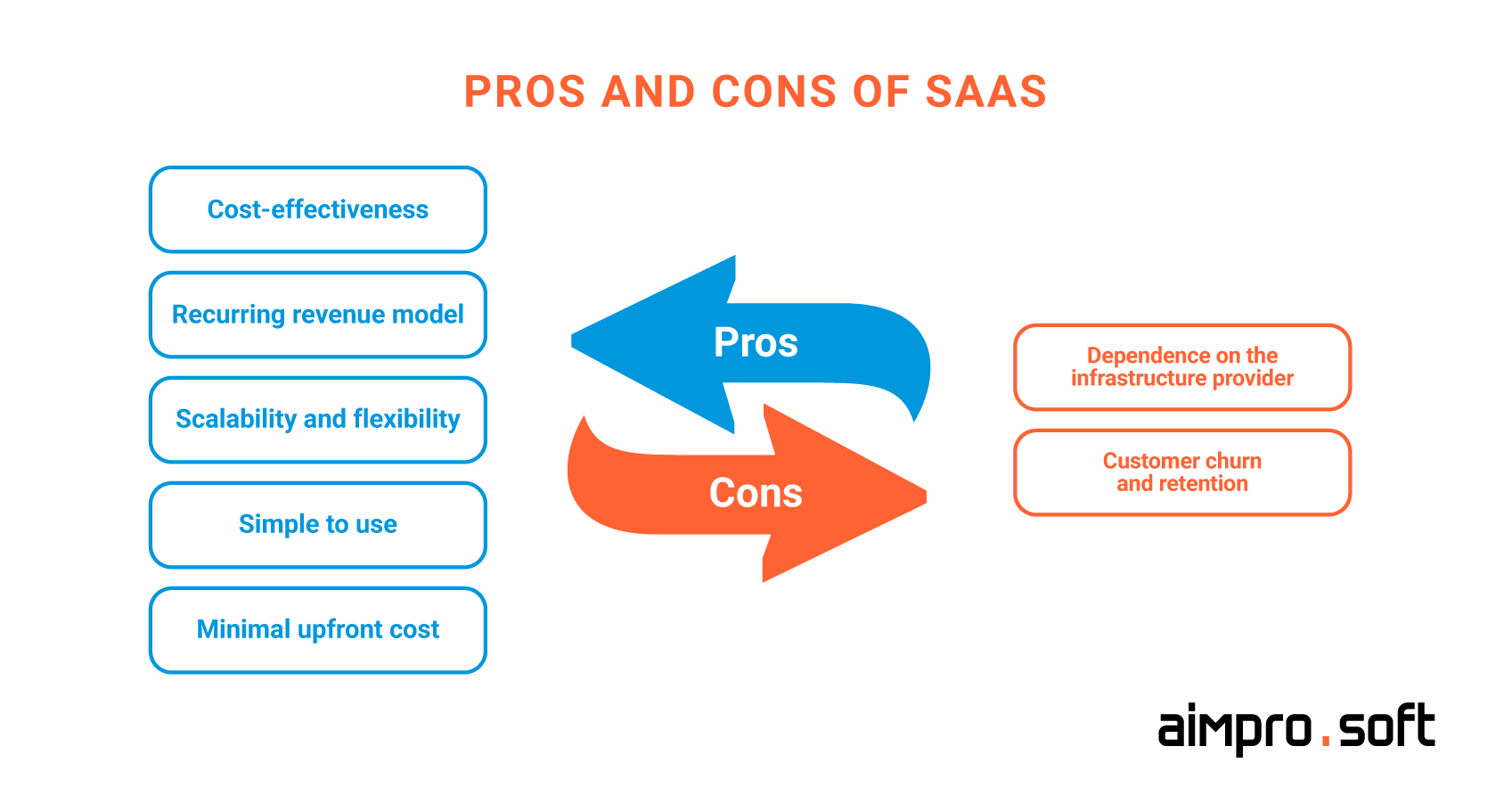
Pros and cons of SaaS
The pros of SaaS
Cost-effectiveness
SaaS web application development often requires fewer resources compared to traditional software creation. By utilizing cloud computing models and pre-built components, companies can avoid substantial upfront hardware costs and reduce the need for extensive infrastructure setup and maintenance. This leads to significant cost savings during the development phase. Companies that provide SaaS based applications reduce maintenance costs by 16.1% with the public cloud, as opposed to supporting traditional applications.
Subscription-based pricing model
SaaS solutions offer a subscription pricing model that provides predictable recurring revenue for companies. This model improves financial planning and stability by delivering a consistent revenue stream over time. It is also possible to provide short free or discounted trial periods so that customers can explore the features of the app before making a decision. This helps to build a solid customer base of users who really need the application.
Scalability and flexibility
SaaS web applications are built to be highly scalable and flexible. Developers can easily accommodate a growing user base and handle fluctuating demands by leveraging cloud-based infrastructure. Scaling resources up or down can be done seamlessly, ensuring optimal performance and user experience during periods of high demand or growth. It is known that 37% of companies use cloud services because of their high level of flexibility.
Simple to use
SaaS products are easily used because best practices and code samples are already integrated. Users can evaluate software functionality or a new version in advance by running trial versions. In addition, your customers can seamlessly migrate to using multiple instances of different versions, all of which items do not require technical skills. Such ease of use provides the best user experience and increases customer loyalty.
Minimal upfront cost
SaaS development services have the advantage of exceptionally low upfront fees, making it easier for businesses to partner and invest in a SaaS plan. The pay-as-you-go model allows companies to commit to purchasing a SaaS solution only when they expect business growth, eliminating the risk of significant financial loss. Reduced customer commitment allows you to partner and provide subscriptions without significant upfront investment. This lowers the barrier to entry, increases the potential customer base, and improves the overall profitability and sustainability of the SaaS business model for providers.
Drawbacks of SaaS
Despite its numerous advantages, web application SaaS also presents certain drawbacks that should be considered when evaluating its suitability for specific business needs.
Dependence on the service provider
With SaaS, businesses depend on the application service provider vs SaaS for the application’s availability, performance, and functionality. For example, if users of the application are uncomfortable with any features or if any functionality is lacking for ease of use, you will need to contact the provider to implement any changes. This dependency can affect delays in updates, which can lead to user churn or a reduction in customer loyalty.
Potential for distrust from clients
Though web application SaaS usually provide robust security measures, there is a risk that customers may have concerns about data security and privacy. This distrust can arise from data breaches, unauthorized access, or vulnerabilities in the SaaS provider’s infrastructure. Application service provider vs SaaS need to prioritize robust security practices, implement encryption protocols, conduct regular security audits, and provide transparent information about their security measures to build trust and address customer concerns.
Nothing in this world is perfect, and neither is the SaaS model, but in this case, the pros really do outweigh the cons. Since we have explored SaaS key characteristics, its advantages, and disadvantages, let’s now focus on studying another prominent category: web applications.
Web applications: detailed overview
This section will examine a web application, its distinctive features, its benefits and drawbacks. We’ll uncover the realm of web applications and identify the unique advantages they offer in the ever-evolving software development landscape.
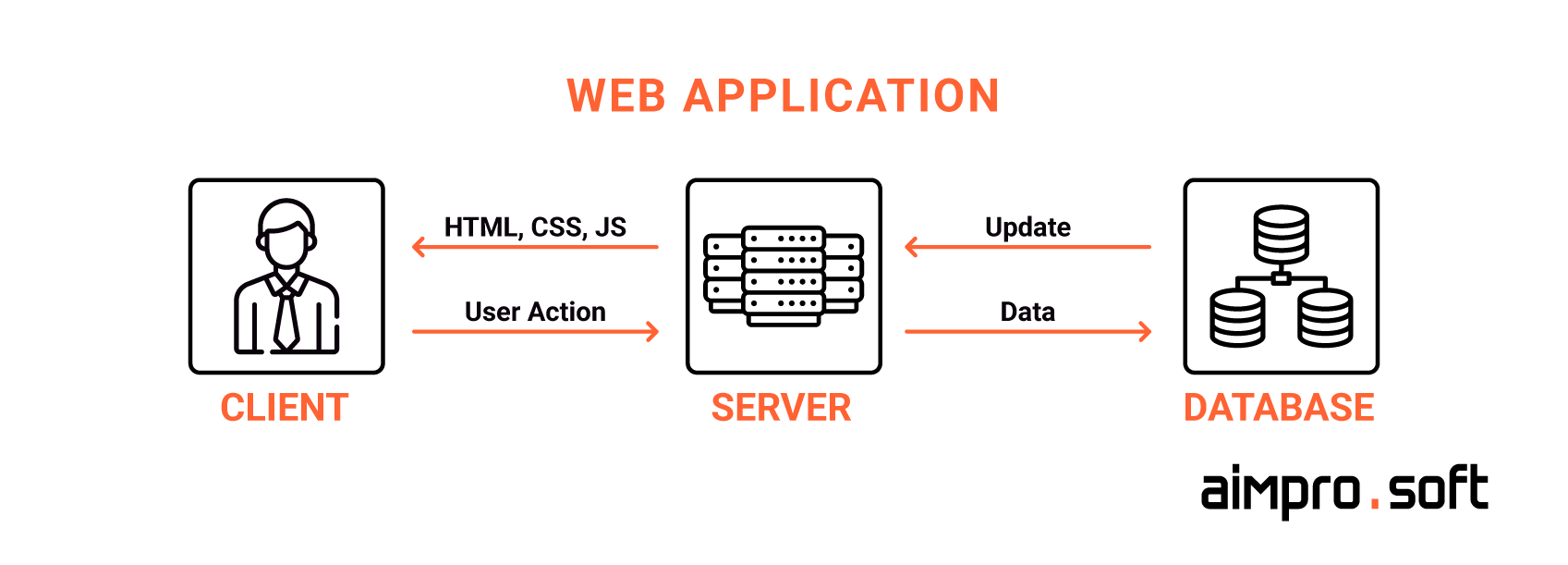
Web applications workflow
While web SaaS has gained significant popularity in recent years, web applications have been a staple in the digital landscape for quite some time. And as we can see from the statistics, such applications have not lost their popularity in recent years, and it is expected that the market for web applications will reach $10.44 billion by 2027.
In general, web applications are software programs accessed through web browsers that allow users to perform various tasks or access specific functionalities over the Internet. They are typically built using web technologies such as HTML, CSS, and JavaScript stack and can offer various features that can help automate tasks, improve performance, and streamline workflows. Web applications can usually be accessed from any device with an internet connection and are often hosted on a web server.
It is important to realize that web applications are a broader term covering different types of applications accessed through web browsers, and the difference between web applications and website is quite blurred. On the other hand, SaaS is a specific category of web applications that operate under a subscription-based model. Comparing SaaS and web applications directly is inaccurate as SaaS is a subset of web applications with distinct features and deployment models. Instead, we can explore their characteristics, benefits, and considerations to make informed decisions based on specific business needs and goals.
Key features and characteristics
Understanding key characteristics that define web applications will shed light on the unique aspects of such apps and help you understand their nature compared to SaaS model.
Platform independence
Web applications are built using web technologies such as HTML, CSS, and JavaScript stack, making them platform-independent. They can run on various web browsers, such as Chrome, Firefox, Safari, and Edge, without requiring any specific installation or configuration for different operating systems.
Collaboration and sharing
Web applications facilitate collaboration and sharing of information among users. Multiple users can access and interact with the same web application simultaneously, allowing for real-time collaboration, data sharing, and concurrent editing.
Social integration
Integrating social features into web applications can increase user engagement and build community. Using social media, users can easily share their wish lists, leave reviews, and even place orders, thereby increasing their interaction with your brand.
So, after exploring what web applications are and their main characteristics, let’s explore the pros and cons of this type of application. In the next section, we will delve into the pros and cons of web applications, providing a comprehensive understanding of their benefits and potential drawbacks.
A сloser look at pros and cons of web applications
In this section, we will provide an overview of web applications’ advantages and potential disadvantages. It is important to consider all factors before developing and deploying a web application. Let’s dive into exploring the advantages and disadvantages of web applications.
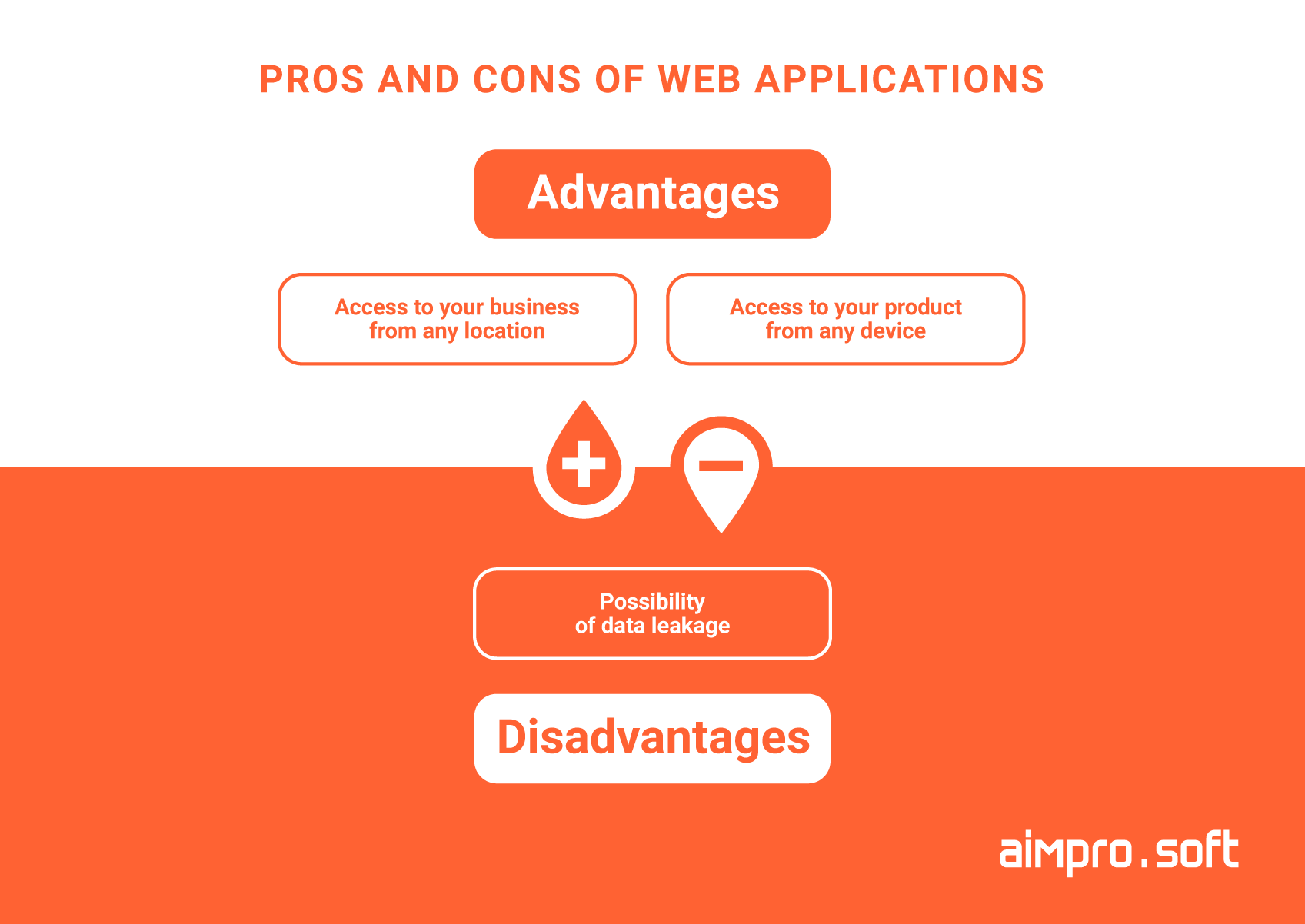
Pros and cons of web applications
Advantages of web applications
Access to your business from any location
A web app is a fantastic method to expand your market reach and reach new customers with your goods or services. People from any location can utilize your services because web apps are accessible from anywhere in the world. For instance, currently, 28% of business is conducted online and the rate keeps growing. The ease and convenience of online transactions have made them popular with consumers, and companies are taking advantage of this by expanding their online presence.
Access to your product from any device
Web applications are accessed through web browsers, making them accessible and compatible with a variety of devices and operating systems. Users can conveniently access the applications from desktops, laptops, tablets, and smartphones, ensuring their ubiquitous accessibility.
Drawbacks of web applications
Possibility of data leakage
Web application development can often run the risk of data leakage when unencrypted protocol HTTP is used. Without the security measures provided by HTTPS encryption, sensitive data such as passwords and personal information are transmitted in the public domain, making them vulnerable to interception and possible exploitation by attackers. Implementing HTTPS is necessary to mitigate these risks, ensure secure data transmission, and protect user information from potential leaks.
It is important to note that while web applications have these disadvantages, they are not insurmountable challenges. With proper planning, technical expertise, and ongoing maintenance, businesses can mitigate these drawbacks and ensure a smooth and successful web application deployment.
Turn to us and we’ll apply the expertise we’ve built up over 18 years
CONTACT USNow that we’ve looked at the main characteristics of web and web SaaS applications and their pros and cons, let’s compare SaaS vs non-SaaS applications to understand better which one you should choose.
Understanding SaaS and stand-alone applications: key aspects
Web applications and SaaS web apps are models that each have unique characteristics. Although they share a common web nature, their functionalities meet different business needs. This section will review the key features of web and SaaS applications to understand their characteristics better. By examining these characteristics, you will have a deeper understanding of how each type of application fits your goals, available resources, and work preferences.
| Point | SaaS applications | Stand-alone applications |
|---|---|---|
| Pricing model | Use exclusively a subscription-based pricing model, where users pay a recurring fee for access and use over a specified period. | Use a pricing model that involves a one-off payment or a subscription-based model where users pay upfront for an application or service. |
| Deployment and hosting | SaaS applications can often be centrally hosted by a SaaS provider who handles product support via the cloud. | Web applications are deployed on dedicated servers, hosted environments, and cloud systems that can be managed by the company or hosted on third-party servers. |
| Customization and flexibility | SaaS applications typically have limited customization options because they are designed to serve a broader customer base with standard features and configurations. | Web-based applications are more customizable, allowing businesses to tailor the application to their specific needs with the help of their in-house developers or service provider. |
| Maintenance and updates | These apps relieve companies of maintenance responsibilities as the vendor handles updates, security patches, and server maintenance. | For web applications, there are several support options, either the company has its own IT department to maintain and update the project, or you can hire an IT provider to do so. |
| Architecture | All users of the SaaS platform share the same application instance and database because the platform is multi-tenant. | In the case of web applications, the architecture depends on the specific needs of the product. |
| Data ownership | In SaaS applications, data ownership is shared between the enterprise and the SaaS provider. The data ownership and processing policy are defined in the service agreement. | In web-based applications, businesses have full ownership and control over their data. They can choose where and how their data is stored and processed. |
Use cases and scenarios for each model
In this section, we look at a few examples of app development use cases. Studying these examples will give you an idea of each approach’s versatility and potential uses.
Use cases of SaaS application development
1. Customer Relationship Management (CRM) software
SaaS-based CRM solutions are ideal for businesses that require centralized customer data management, lead tracking, and sales automation. The cloud-based nature of SaaS enables easy access, scalability, and integration with other business systems. Such SaaS platforms are highly popular in the market, with 91% of companies with ten or more employees using a CRM to manage their interaction with clients.
2. Human Resources Management (HRM) systems
SaaS HRM platforms are beneficial for organizations that need efficient management of employee data, payroll processing, leave management, and performance evaluations. The SaaS model provides flexibility, cost-effectiveness, and regular updates to comply with changing HR regulations.
3. Project management tools
SaaS project management platforms help companies plan, track and collaborate on projects. These platforms offer features such as task management, team collaboration, file sharing, time tracking, and progress reporting. The market for project management software is predicted to be worth $9.81 billion by 2026, demonstrating the demand for the creation of such platforms.
4. Accounting and financial management software
SaaS accounting and financial management applications provide businesses with invoicing, expense tracking, budgeting, financial reporting, and tax management tools. Such applications can handle complex calculations, providing secure data storage and regular software updates.
Web application development use cases
1. News web applications
Developing a news web application has several benefits for both businesses and users. A news web application provides access to relevant and personalized news content for potential users. Users can easily browse through different news categories, customize their preferences, and receive real-time updates on topics of interest. For companies, news apps can attract many users, providing ample opportunities to advertise and generate revenue through partnerships with news outlets or sponsored content.
2. Information management apps for C-level
One of the best web application ideas are corporate solutions with feature-rich dashboards, which give CEOs and other C-level executives a clear, in-depth view of corporate data in the way they like. They can access the data they require to make decisions and analyze it. With a scalable and trustworthy information management web app, users can work with other people in the field to solve problems while having all of the data in one location.
3. Web-based dating apps
Web dating apps provide an online platform for individuals to connect and interact with potential romantic partners. These apps leverage web technologies to offer features such as user profiles, matching algorithms, messaging systems, and search filters. The growing popularity of online dating provides a large user base and market demand for such apps; for instance, the number of users of such ads has grown to 366 million in 2022. In addition, web dating apps can generate revenue through subscription models, in-app purchases, premium features, or advertising.
4. E-learning platforms
Educational institutions, including schools, have been obliged to migrate online in order to support e-learning as a result of the epidemic. With no subject restrictions, an online learning platform offers students a variety of learning options. It is also convenient for teachers to post their recorded or live-streaming videos on a particular subject and easily track students’ progress. Such platforms will remain popular in the future, forecasting that the number of users of online learning will rise to 57 million by 2027.
If you have an idea for your own app, it is worth examining the important factors to consider before development, let’s look at them below.
You can always contact us, and our experts will develop the best product according to your request.
CONTACT USFactors to consider when choosing between SaaS and a traditional web application
In this part, we’ll look at the factors that need careful consideration when choosing between developing a SaaS or web application. By examining them, you can confidently navigate your decision-making process, ensuring your choice aligns with your goals.
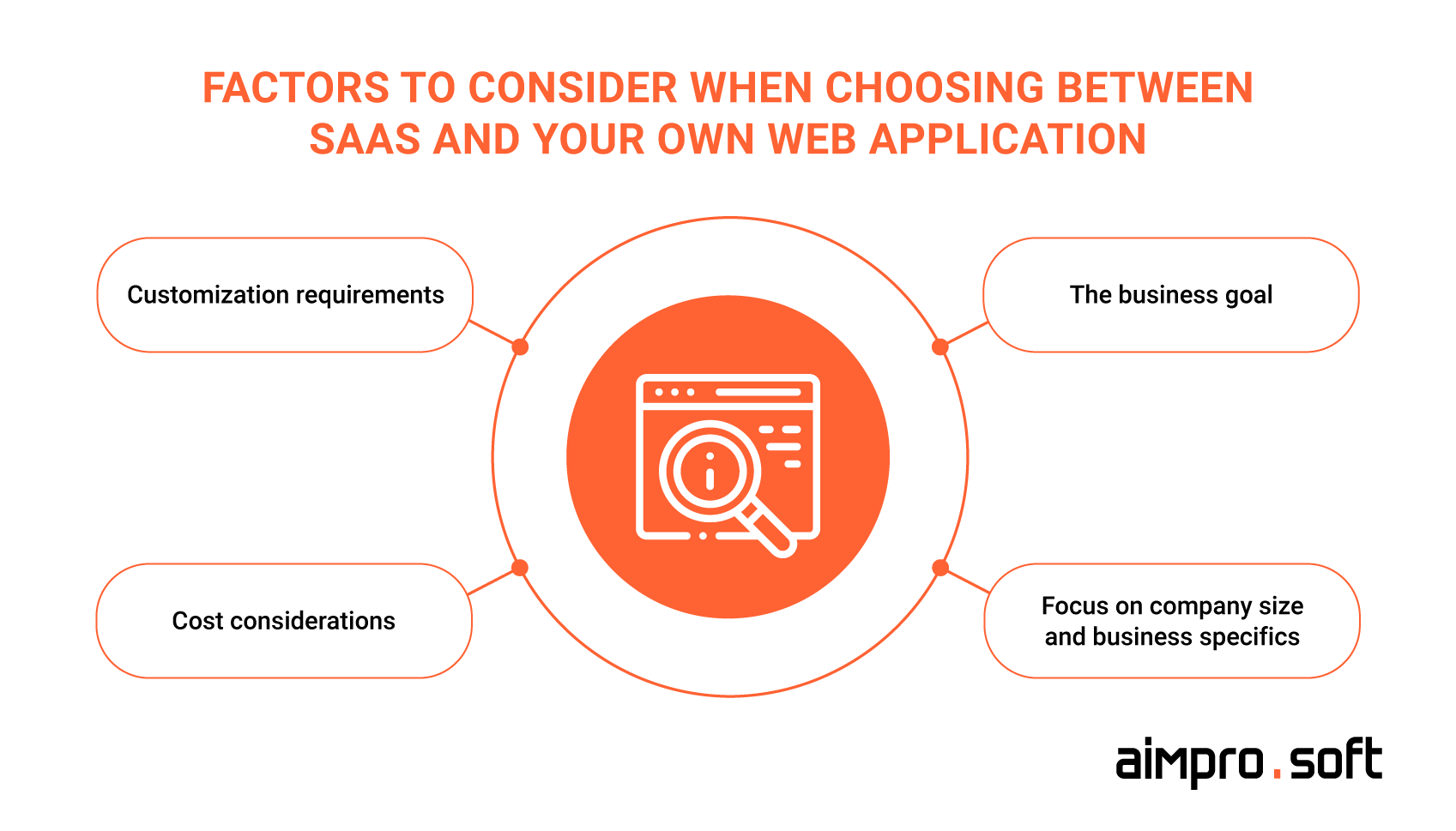
Important factors before making a decision
1. The business goal
One of the most important factors to consider when choosing between a SaaS application and a regular web application is the business purpose. The SaaS model is primarily a business model. SaaS is worth choosing if your goal is to sell your application on a subscription basis to other companies or make the platform available to a wide range of customers. The SaaS approach can even be compared to the B2B model since you are offering your platform to other businesses in most cases.
Web-based applications can also be designed to serve multiple customers or organizations in the same way as SaaS applications. But while SaaS applications are usually offered as a centralized, multi-tenant solution to various customers, web applications can be designed and deployed for a specific client or organization, providing a more tailored and specialized experience. A clear definition of your business objective will be the starting point in the decision between regular web applications and SaaS solutions.
2. Customization requirements
Assess the level of customization your application requires. SaaS applications often offer standardized features and limited customization options to cater to a wide range of users. If your business demands unique workflows or specific functionalities, a web application provides greater flexibility for customization.
3. Focus on company size and business specifics
For start-ups and small companies, off-the-shelf SaaS systems may seem advantageous due to their cost-effectiveness and speed of implementation. However, as a company grows, the limitations of SaaS functionality may need to be improved, resulting in a custom web application to meet specific requirements and provide scalability. Custom web applications offer greater flexibility to customize features to meet the company’s changing needs, ensure optimal performance and cater to unique business requirements.
4. Cost сonsiderations
Evaluating costs from a company’s perspective is critical to making an informed decision that fits its budget and long-term financial goals. By choosing a SaaS model, companies can take advantage of subscription-based pricing, which often eliminates the need for upfront investment in infrastructure. It’s also much more expensive to write a product from scratch. This allows companies to manage costs more efficiently and direct resources to other areas of activity. In contrast, web-based applications may require more upfront development costs, but provide greater control over ongoing maintenance and infrastructure costs.
By considering these factors, enterprises can make an informed decision as to whether SaaS or web-based applications are appropriate for their specific needs. Each factor is weighted differently depending on the organization’s requirements, budget, scalability goals, customization needs, and data security considerations.
Aimprosoft is your best provider for creating your own solution
So, we have analyzed and compared web and SaaS applications and studied all the pros and cons. And if you have decided on an idea for your own solution and you are looking for a reliable provider who will be able to implement your project, you can always turn to Aimprosoft for help. Here are a few reasons why consider us for a potential cooperation:
- 18+ years in the IT industry;
- 600+ released projects;
- We have experience in 20+ domains, including education, e-commerce, healthcare, real estate, retail, telecom, and IoT;
- We currently have over 100 clients from various regions all over the world, including ones from the U.S., Europe, Canada, and Asia.
Examples of SaaS and web applications from our portfolio
SaaS app: KubKaf
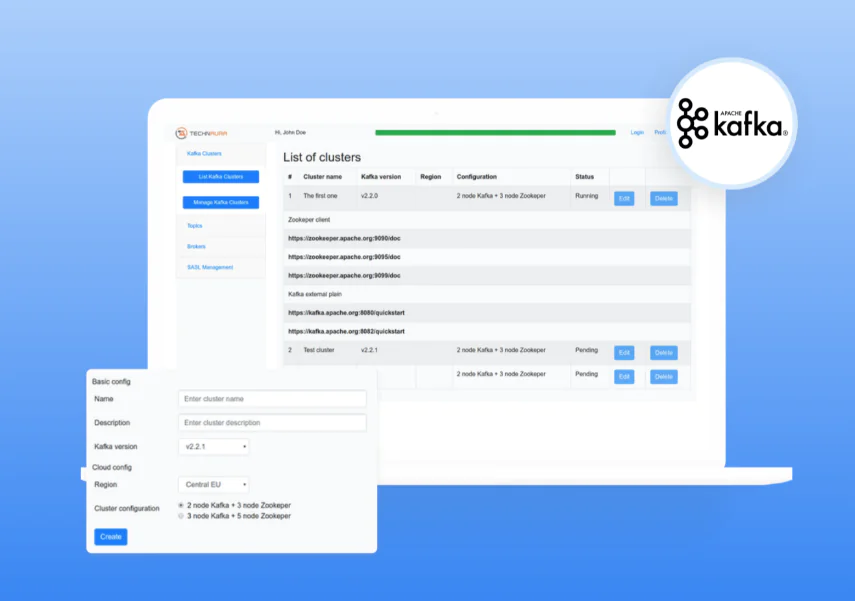
KubKaf interface
KubKaf, a game-changing product that simplifies cluster management. Our scalable and fault-tolerant solution provides users with a seamless experience.
The client’s goal was to develop a cutting-edge SaaS platform that simplifies Kafka deployment and maintenance, catering to users with varying technical skills. Our team successfully delivered a highly efficient solution using Scala technologies and robust microservices. These services address cluster management, user profiles, and account management, ensuring a streamlined experience for users.
Web app: HomeLike
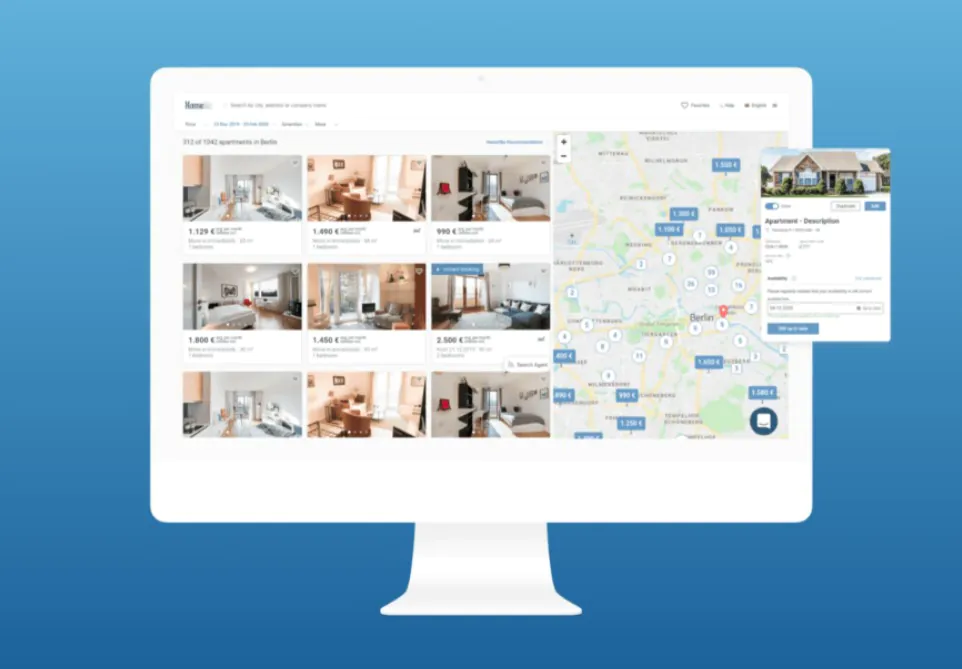
HomeLike interface
HomeLike is a platform for corporate housing that enables businesses and tenants to utilize real estate services’ capabilities fully. The client requested that we revamp the business logic of an existing, outmoded rental marketplace and enhance its feature set.
Our team successfully transformed an outdated rental marketplace into a feature-rich rental platform catering to landlords and tenants. With advanced tools for landlords to manage their offers and an extensive apartment search and booking functionality for tenants, HomeLike provides a seamless experience. We also developed an admin panel, integrated third-party services, and implemented features such as agreement signing, ensuring a reliable and secure platform for landlords and tenants alike.
With a large field of specialists across the spectrum, we have enough resources to make any idea you have come up with reality. Whether it’s a web app or a Saas app, you can always turn to us, and we’ll find the best solution for you.
Contact us, and we will create together a solution that meets all your business objectives.
CONTACT USConclusion
So, by examining the nature of the web application and SaaS model, carefully comparing their pros and cons, and analyzing their unique characteristics, you can make an informed decision that meets your business objectives. Armed with a deeper understanding, you can confidently chart your way forward. If you decide to develop your own solution, we’re ready to be your trusted partner, contact us, and we’ll provide you with our experience and knowledge to bring your vision to life.
FAQ
Are there any drawbacks to using SaaS?
One drawback is the dependency on the service provider, as businesses rely on their infrastructure, updates, and support. Additionally, security and data privacy concerns may arise, especially when sensitive information is stored or accessed through a third-party provider. Limited customization options may also be a drawback for businesses requiring highly tailored solutions.
Can I switch from SaaS to a web application or vice versa?
Switching from SaaS to a web application or vice versa is possible but may involve challenges. You may encounter problems such as complex and time-consuming data migration, integration changes, and adaptation to different infrastructure and deployment models. This requires careful analysis, planning, and possible adjustments to ensure a smooth transition. But before moving as a business owner, you must ask yourself why you need it and what it will bring to your business. It all depends on the specific case. For example, if SaaS provides you with the necessary minimum, then there is no point.
Can web applications be hosted on cloud platforms?
Yes, web applications can be hosted on cloud platforms, such as Amazon Web Services (AWS), Microsoft Azure, or Google Cloud Platform (GCP). Cloud hosting offers scalability and flexibility for web applications.
Can SaaS and web applications be used offline?
Whether SaaS and web applications can be used offline depends on the specific product’s features and design. It is essential to consider the specific needs and requirements of your application when determining its offline usability.
What are the typical pricing models for web applications?
Typical pricing models for web applications include several options. One-off payment models involve a one-off upfront payment for the perpetual use of the application. Subscription-based models offer recurring payments at regular intervals, often monthly or annually, providing access to the application and its updates. These pricing models offer flexibility, allowing companies to choose the approach that best suits their revenue goals and customer needs.




